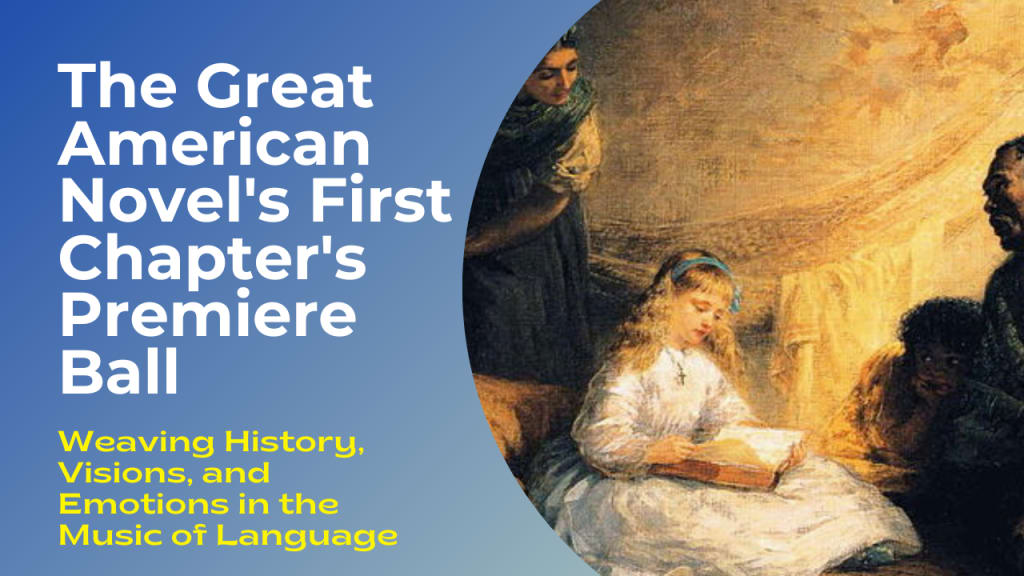The Great American Novel's First Chapter's Premiere Ball
Weaving History, Visions, and Emotions in the Music of Language

The Great American novel's 'First chapter' is a complicated dance of words that lures readers in with a mix of familiar and mysterious worlds. The blazing fabric of American history and the private tales of its different personalities are woven together in the author's deft strokes to create a vivid view. A symphony of feelings, aspirations, and hardships are woven together in these pages to illustrate the nation's journey through time. The story catches the very essence of an entire civilization, reverberating in each carefully selected word, repeating the beating heart of a nation, and the reader becomes an active participant in the desires and anxieties of the characters with every phrase.
The evolution of narrative writing is a fascinating journey that sheds light on historical shifts in culture, society, and thinking when viewed from the perspective of the history of literature. The USA was eventually founded as a result of political conflict between Europe and the British colonies prior to the Revolutionary War. Although prose fiction captivated readers in Europe, it was difficult to distinguish in America, which resulted in the formation of a unique, modern American narrative style. In addition to exploring the history of literary tragedy and book reading, this blog article delves into the origins of the first American novelists.
A Tragic Story of Colonial Beginnings
The literary environment had not yet undergone a similar revolution as the political landscape changed as a result of the American Revolution. Despite being popular in Europe, American audiences had trouble understanding narrative literature. While the colonies struggled to develop their own novel traditions, Europe was home to literary giants like Richardson, Fielding, and Smollett. It was a critical turning point when Richardson's "Pamela" was published in Philadelphia in 1744, but it wasn't enough to spark a literary revolution.
Literary conservatism and cultural anthropology
A clash of tastes and cultures between European influences and the need to uphold colonial identity might be blamed for the colonies' resistance to narrative writing. Pope and Addison served as role models and helped to create a conservative literary climate. Additionally, the abundance of political and religious preaching detracted from creative spaces. The literary sadness that persisted during this period in culture helped give rise to a new kind of narrative fiction.
A Rising Tempest: Changing Perspectives
Post the American Revolution, a seismic shift occurred as novel reading gained rapid popularity. The emergence of native American novelists challenged the status quo and gave birth to various viewpoints. Moralists criticized the influence of novels on society, and contemporary publications showcased a fascinating array of arguments, claiming novels were either deceptive or lacked good intentions. These diverse arguments shed light on the growing role of literature in a changing society.
A Gathering Tempest: Diverging Viewpoints
Novel reading saw a seismic shift after the American Revolution as it quickly surged in popularity. Native American novelists' emergence was a challenge to the established order and gave rise to a range of opinions. Novels were criticised for their impact on society by moralists, and contemporary publications presented a fascinating range of defences for their claims that they were either dishonest or lacking in virtue. These various justifications provide insight into the expanding significance of literature in a society in transition.
European mentors' impact
It is impossible to ignore the impact of English novelists on American literature. The merits of the mirror were vigorously disputed by Fielding, Smollett, Sterne, and Richardson, followed by arguments from Dickens and Thackeray. The attractiveness of Fielding's wit, smallest firmness, Sterne's humour, and Richardson's emotional grip on the readership varied. The apex of early American novels—the publication of Sarah Wentworth Morton's "The Power of Sympathy" in 1789—was the result of Richardson's enduring influence and Sterne's stylistic features.
The Rise of American Idealism
The earliest American novel was "The Power of Sympathy," which Sarah Wentworth Morton published in 1789. It explores deep human feelings, relationships, and societal issues in an epistolary manner. Despite receiving a mixed response, the book was an important turning point that heralded the emergence of American narrative writing and opened the door for succeeding generations of authors.
The growth of narrative literature in pre- and post-revolutionary America reflects the complex interactions between culture, society, and philosophical currents. Despite the clamour of critiques, the initial mistrust of the novel's approach soon gave way to acceptance. The transition from novel exploration to literary conservatism presents a vivid image of a society that influenced the study of American writing for future generations.





Comments
There are no comments for this story
Be the first to respond and start the conversation.